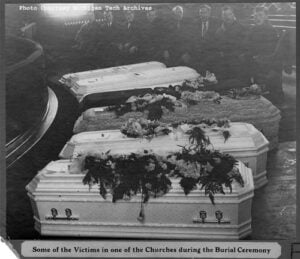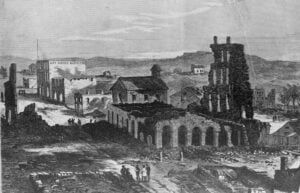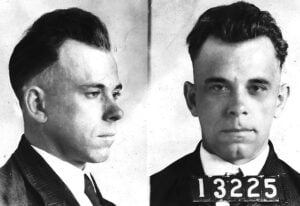Murder at Starved Rock
A grizzly, triple-murder at one of the most beautiful spots in Illinois.

exc-5c8922bc6e9a7f2095b1b63c
Starved Rock State Park, two hours southeast of Chicago, is one of the most beautiful spots in Illinois. The park was named after an isolated rock towering above the Illinois River. According to legend, the Ottawa and Potawatomi tribes cornered a band of Illiniwek Indians on the rock, where they starved to death.
On March 14, 1960, Mildred Lindquist, Lillian Oetting, and Frances Murphy drove from their home in Riverside, Illinois. They decided to flee the city for a weekend at Starved Rock State Park.
The three women were looking forward to seeing sights like the waterfall at the park’s St. Louis Canyon. The women pulled up at the Starved Rock lodge in a gray station wagon, checked-in, and ate lunch. Remarking on the beautiful weather, they embarked on a hike toward St. Louis Canyon, a mile away.
The three women were never seen alive again.
Two nights later a snowstorm hit. Oetting’s husband tried to call his wife. Without any luck, he asked an employee at the lodge to check their rooms. The rooms were empty other than their unopened luggage.
The Illinois State and local police commenced a search for the women. But the inches of snow hid any trace of the three women.
Meanwhile, a group of boys were scouting the area during an Illinois Youth Commission forestry camp. They discovered three bodies of Oetting, Lindquist, and Murphy.
The three mutilated women were lying side-by-side on their backs, covered with snow. Under a small ledge, their bruised legs were spread open and their lower clothing was torn. The Starved Rock murder victims’ heads were bashed in, and two of the bodies were tied together with heavy twine.
A trail of gore led deeper into the canyon, suggesting their bodies were dragged and placed under the rock ledge.
Mrs. Murphy’s camera was found about ten feet from the bodies. Its leather case was smeared with blood and its strap was broken. They also discovered the women’s blood-stained binoculars. LaSalle County’s States Attorney, Harland Warren found a frozen tree limb soaked with blood a short distance away.
The murder weapon
For months, the case was cold. The once thriving state park, was now mostly abandoned.
Eventually, La Salle County’s Harland Warren, using his own money, purchased a microscope to conduct a study of the twine. His research revealed there were two kinds of twine used, a 20-ply cord and a 12-ply one. He took this information with him and sent two county deputies to the lodge.
In September 1960, Warren and his deputies met with the manager of the lodge’s kitchen. Within minutes, Warren found both kinds of twine used in the murders. They were each used for wrapping food. The men tracked down the twine’s manufacturer. The twine used to bind the Starved Rock murder victims was taken from the supply in the lodge’s kitchen.
The killer worked at the lodge
Warren glanced over the polygraph results they had done before on the lodge employees. The employees passed. But Warren decided he would conduct his own tests.
A specialist from a prominent Chicago firm was hired. Warren recalled the employees that worked during the week of the Starved Rock murders. The first dozen or so were cleared. Then a deputy brought in a former dishwasher named Chester Otto Weger. When the polygraph test was completed, the technician turned to Warren and said “that’s your man.”
Weger, 21, was a slight, small man with a wife and two children. He worked at the park until that summer when he went into business with his father as a house painter.
Weger happily cooperated with the investigation. He handed the police a piece of a buckskin jacket he owned with suspicious “dark stains”. Analysis showed it was human blood, but in 1960, it couldn’t be matched to a specific victim.
Warren also asked Weger to submit to further polygraph tests and Weger agreed. He was given a series of tests and he failed them all.
Confession to the Starved Rock murders.
Weger said he dragged the bodies under the overhang in St. Louis Canyon, because a small airplane flew low over the park. Weger thought it could be a state police plane. A few days later, a pilot confirmed his flight over the park.
Weger confessed several more times. He even re-enacted the killings for a crowd of policemen and reporters at the canyon.
A changing story
After his first meeting with his court-appointed attorney, Weger changed his story and stated that he was innocent of all charges. Weger claimed the deputies held him at gunpoint and forced him to confess to the Starved Rock murders and sign the papers. Weger also said that Dummett gave him the information about the airplane. He claimed to be in Oglesby at the time of the killings.
The trial began on January 20, 1961. Charges were filed against Weger for only one of the three murders. (If in the event of a mistrial or an acquittal, they could file charges against him for the other killings.) They sought the death penalty.
On March 4, almost exactly a year after the Starved Rock murders, the jury brought back a guilty verdict for Chester Weger. On his twenty-second birthday, he was sentenced to life imprisonment.
Chester Weger is still incarcerated at the Statesville Penitentiary in Joliet. He has been denied parole over two dozen times.





